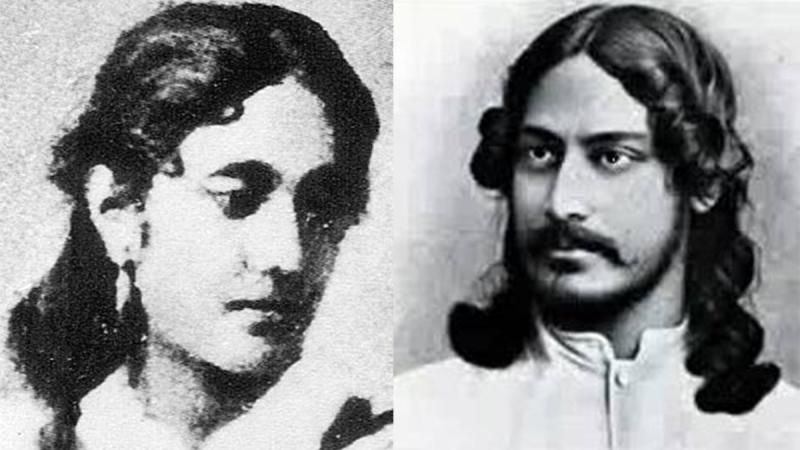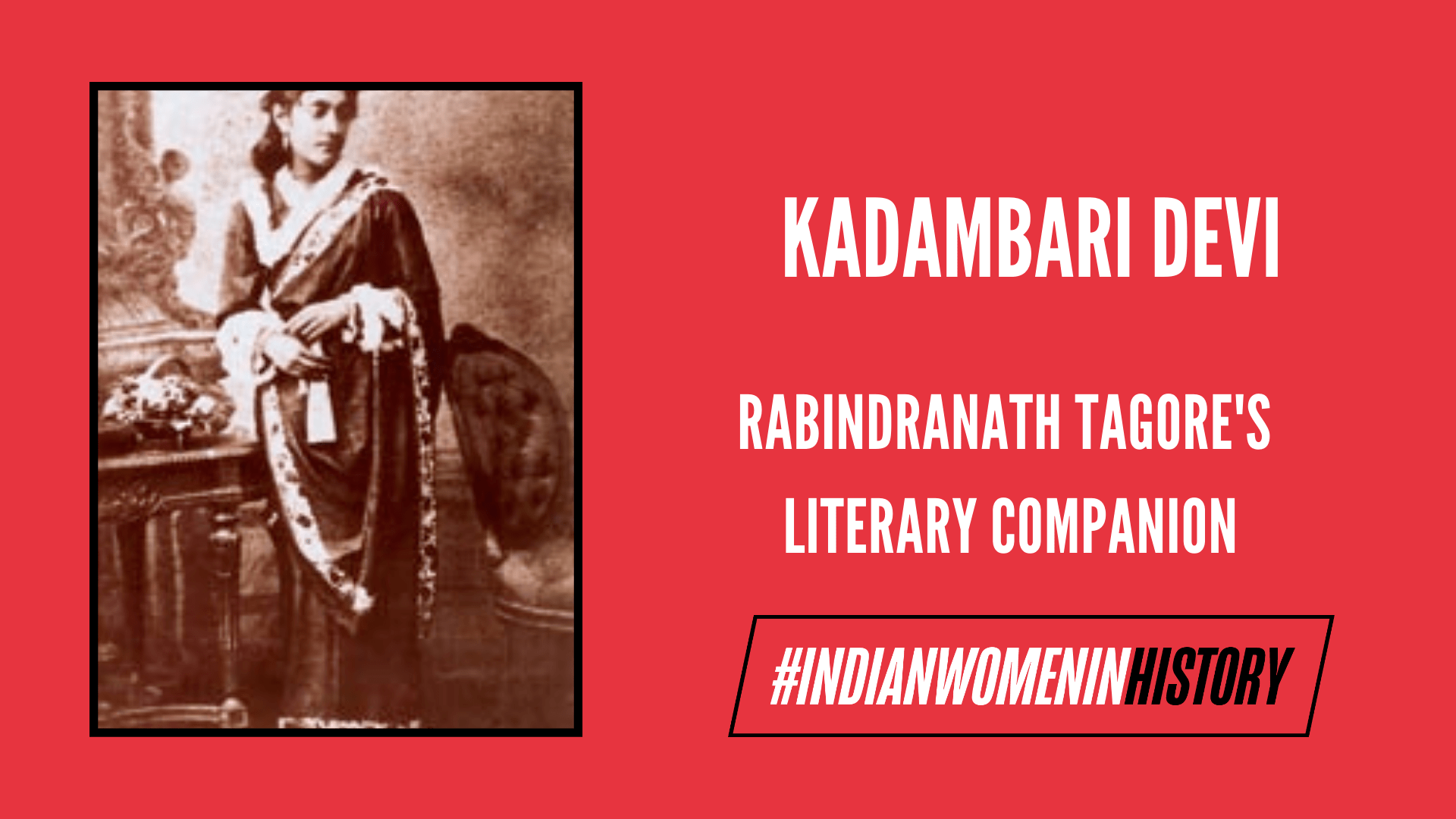Kadambari Devi was married into one of the most prominent Bengali families of 19th century in Kolkata. From an innocuous beginning, she rose to become a literary companion of Rabindranath Tagore. By a quirk of fate, she ended her youthful life by committing suicide on April 21th, 1884. Though numerous theories have been forwarded from time to time, the mystery behind her premature death is yet to be unraveled. Till date, Kadambari Devi remains an enigmatic figure in the entire gamut of Tagorean literature.
Early Years
She was born in 1859 and was given the name Hemangini. Her father was a domestic employee in the Tagores’ residence in Jorasanko, Kolkata. In 1868, she was married off to Jyotirindranath Thakur (Tagore’s brother) who was much older than her. It is believed that Maharshi Debendranath, the great humanitarian and philosopher, selected her as his son’s wife, not giving thought to the class difference.
In his autobiographical masterpiece My Boyhood Days (Chhelebelai), Rabindranath depicts his first glimpse of Kadambari as, “A new bride came to the house, slender gold bracelets on her delicate brown hands…I circled around her at a safe distance, but I did not dare to go near. She was enthroned at the centre of affection and I was only a neglected, insignificant child …” Fortunately for the lad, the new bride, whom he addressed as notun bouthan/bouthakrun (the new sister-in-law), was assigned the duty of looking after him.
As she was barely two years older than Tagore, the duo became playmates and companions.
She would supervise his meals after his return from school. An expert cook and efficient home maker, she dished up delicious dishes for her brother-in-law (as was expected of her) and cared dearly for him. As she was barely two years older than Tagore, the duo became playmates and companions. Tagore’s memoirs are replete with anecdotes about the duo’s mock fights, quarrels, followed by patch-ups. After his mother passed away in 1875, she began taking greater care of the lonely and grieving motherless boy.
Education And Training
The Tagores believed in educating their daughters-in-law. Jyotirindranath made adequate arrangements for his wife’s education at home. She also learnt horse riding from her liberal husband. Every evening the couple would ride out to the maidan. Her ‘daredevilry’ left Kolkata’s high society horrified!

Adolescence And Youth
As the years passed by Tagore and his bouthan had metamorphosed from children to youths. Yet their camaraderie remained intact. As Kadambari remained childless even after many years of wedlock, she shied away from her women relatives to escape their thoughts of internalised misogyny. Her bold spirit brushed off all negativity that surrounded her. A diehard romantic, her imaginative mind reached out to her creative brother-in-law, in whose company she felt the happiest.
Also read: Finding Feminism In Rabindranath Tagore’s Streer Patra
During sultry summer afternoons, while Jyotirindranath would be busy at the office, handling administration and management of the family estates, Tagore would read out loud his poetry to Kadambari. At other times they read serialised versions of author Bankim Chandra’s novels in the popular journal, Bangadarshan. He disclosed how Kadambari often teased him about his works but also persuaded him to read to her, while he “shared the benefits of my sister-in-law’s hand fan,” (electricity was nonexistent even in affluent households those days). About his poems, Tagore said that he wrote them sitting next to her, and all the memories of those affectionate moments are alive in these poems.
In the evenings, Tagore joined Jyotirindranath and Kadambari on the terrace (adjoining their chamber) that she had tastefully decorated with potted palms and highly aromatic flowering shrubs. Jyotirindranath would play the violin while Tagore would sing in his treble voice. Occasionally, like-minded family friends and acquaintances would drop in to enjoy these sessions. During these enchanting, dream-like hours, notun bouthan was a patient listener and enjoyed to her heart’s content.
Tagore Companion And His Muse
Gradually, an intellectual (read literary) relationship was fostered between Tagore and his bouthan. A sensitive soul, she had developed a literary sensibility, which enabled her to give feedback on Tagore’s creations. She was his best friend and harshest critic, perpetually urging him to bring forth his best. No wonder the youthful bard considered her his muse. At 19, Tagore dedicated his famous lyrics Tomarei koriachhi jibaner dhrubo tara (Thou art the guiding beacon of my life) to her, exalting her for being his source of inspiration! He even nicknamed Kadambari after Hecate, the Greek goddess of night, moon, and magic.
she had developed a literary sensibility, which enabled her to give a feedback on Tagore’s creations.
Her Marriage
For major part of his adult life, Jyotirindranath juggled family business/estates with his creative pursuits. With the passage of time he got more and more involved with managing the family’s fortunes. Consequently he spent very little time at home. Kadambari realised with dismay that her spouse had hardly any time for her! This attitude possibly acted as a catalyst and further pushed her closer to Tagore who spontaneously provided the companionship she craved for.
Clouds Of Adversity
When he was 17, Tagore had a brief stint in England; however he maintained regular correspondence with Kadambari. Later, he got some of the letters published. Though they were brilliant literary pieces yet their emotional contents left his family scandalised. The elders of the family started construing his relationship with Kadambari as passionate and sexual. They soon decided to get him married. Kadambari was staunchly opposed to the marriage; but being a low profile individual, in a patriarchal home, she could do nothing.
Accordingly, on 9th December 1883, 22-year-old Rabindranath married an 11-year-old Bhavatarini Devi, whom he later named Mrinalini. The event proved highly traumatic for Kadambari. All along, the childless, lonely, neglected wife had found solace in Tagore’s company. He had been a ray of hope in her darkened life. The idea of widening distances, a void, was unbearable to her.
In about four months and ten days after Rabindranath’s wedding, she took her life, through an opium overdose! Her death left Tagore distraught and heartbroken. In a letter to C. F. Andrews, his close associate, social reformer and educationist, he wrote, “But where is the sweetheart of mine who was almost the only companion of my boyhood and with whom I spent my idle days of youth exploring the mysteries of dreamland? She, my Queen, has died and my world has shut against the door of its inner apartment of beauty which gives on the real taste of freedom.”
Also read: The Life and Times of Literary Iconoclast Ismat Chughtai | #IndianWomenInHistory
Rabindranath kept alive the memories of his beloved bouthan within his soul, lifelong. For years after she was gone, he continues to write about her. He penned the lyrics “Tobu Mone Rekho” (Pray, love, remember), which is a popular Rabindra Sangeet, in her honour. Another song composed in her memory, Amaar praner pore chole gelo ke (The one who went out of my life) too evokes pangs of separation, indicating the huge role she played in his life.
References
1. Telegraph India
2. Free Press Journal
3. Youth Ki Awaaz
About the author(s)
Delhi based Ruchira Ghosh is a trained journalist with nearly two & a half decade’s writing experience and exposure to print, web and television.




